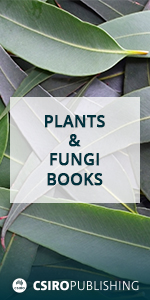
Functional Plant Biology
Volume 43 Number 10 2016
FP16062Water deficit stress tolerance in chickpea is mediated by the contribution of integrative defence systems in different tissues of the plant
Water deficit stress is a major constraint to chickpea yield and there is need to identify the physiological and biochemical indices of drought tolerance. Water deficit stress tolerance in chickpea is mediated by antioxidative defence mechanisms in different underground (roots and nodules) and aboveground (leaves, pod walls and seeds) tissues. The study can be used for enhancing the sustainability of agricultural practices in low-moisture soils.
FP15384Truncation of grain filling in wheat (Triticum aestivum) triggered by brief heat stress during early grain filling: association with senescence responses and reductions in stem reserves
Short heat waves during grain filling significantly reduce grain size and consequently yield in wheat. Heat caused grain filling in intolerant varieties to be cut short rather than slowed, pointing to premature senescence in the grain as the determinant of grain weight losses under heat, rather than reduced sugar supply to the grain caused by rapid loss of leaf greenness. Efforts to improve the heat stability of grain size could therefore focus on preventing heat-triggered senescence in the grain.
FP15384 Abstract | FP15384 Full Text | FP15384PDF (647 KB) | FP15384Supplementary Material (691 KB) Open Access Article
FP15339Different photosynthetic acclimation mechanisms are activated under waterlogging in two contrasting Lolium perenne genotypes
Increased precipitation during warmer winters may lead to low-temperature waterlogging. The aim of the study was to evaluate the effects of cold waterlogging on photosynthesis: it was shown that different photosynthetic acclimation systems are activated. The results indicate that the predicted climatic changes may modify cold acclimation process in plants.
FP15363Effects of exogenous nitric oxide on growth, proline accumulation and antioxidant capacity in Cakile maritima seedlings subjected to water deficit stress
Nitric oxide (NO) is an endogenous signaling molecule mediating plant responses to environmental constraints. The effect of exogenous NO was investigated in Cakile maritima seedlings under water deficit stress, using sodium nitroprusside as NO donor. NO supply mitigated the impact of water deficit stress on C. maritima by the stimulation of proline biosynthesis and the reduction of oxidative damage.
FP16007Stress tolerance mechanisms in Juncus: responses to salinity and drought in three Juncus species adapted to different natural environments
Responses to salinity and drought were analysed in three rush species with different degrees of salt tolerance. The most tolerant species – sea rush and spiny rush – were more efficient in inhibition of the transport of toxic ions to the aerial part of the plants, activate potassium transport at high external salt concentrations, and accumulated much higher levels of proline as an osmoprotectant. These findings contribute to elucidate relevant stress tolerance mechanisms in Juncus species.
FP15362Do wheat breeders have suitable genetic variation to overcome short coleoptiles and poor establishment in the warmer soils of future climates?
The effects of high temperature on reproductive growth have been a focus in climate change research. However, concomitant increases in air and soil temperatures will substantially reduce coleoptile elongation, limiting wheat establishment, particularly when wheat is sown early into deeper soil moisture. Improved management, together with selection of new and existing alleles for greater coleoptile length, will be required to avoid crop establishment failures in future climates.
FP16153Early interconnectivity between metabolic and defense events against oxidative stress induced by cadmium in roots of four citrus rootstocks
Cadmium (Cd) is the main heavy metal that limits plant productivity worldwide. Antioxidant mechanisms of the four citrus rootstocks exposed to environmentally-realistic concentrations of Cd were characterised. We found that roots differ in the ability to cope Cd-induced oxidative stress through differences in metabolic and antioxidant events involving carbohydrates, soluble and polymerised phenolics, lipid peroxidation and reactive oxygen species accumulation. We propose a hypothetical model to explain differences observed in this study.
FP16067Establishing the temperature dependency of vegetative and reproductive growth processes and their threshold temperatures of vineyard-grown Vitis vinifera cv. Semillon vines across the growing season
Vegetative and reproductive growth of many plant species is detrimentally affected by high temperatures, but it is not known just how high the temperatures have to be to cause damage. In this work, a hydrocooling system was used to control grapevine canopy temperatures at set points. The results showed many processes such as dry matter accumulation were optimal at 30°C, therefore, where some depreciation was evident suggested a threshold temperature was 35°C and exposure to 40°C was distinctly detrimental.




